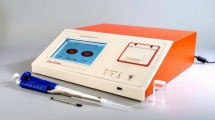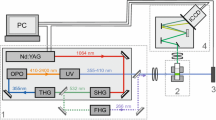Abstract
Spectroscopic characteristics of aqueous uranium(VI) (U(VI)) (0.01–1 μΜ) and its quantification procedure in the presence of Fe(II) (≤0.09 mM) have been developed at pH 7 using TRLFS. The measured fluorescence properties of U(VI) in the phosphate solutions showed the co-presence of UO2HPO4 (aq) and \({\text{UO}}_{2} {\text{PO}_{4}}^{ - }.\) The fluorescence signals of each species were remarkably quenched following dominantly static quenching process via the formation of non-fluorescent complexes. An empirical equation correcting the quenched fluorescence intensity was developed and the corrected values of quenched U(VI) intensity showed a consistency (≥93.39 ± 2.27 %) with the measured uranium concentration by ICP-MS.
Graphical Abstract
We firstly confirmed that aqueous U(VI) quantification by TRLFS can be significantly interrupted by Fe(II) quenching via dominantly a static quenching process. The novel analytical procedure for correcting quenched fluorescence intensity (concentration) of U(VI) was developed based on the relationship of the quenched intensity and Fe(II) concentration at neutral pH.

Fluorescence quenching relations of U(VI) fluorescence intensity and Fe(II) concentration for accurate quantification of U(VI) under F(II) quenching








Similar content being viewed by others
References
Cho H-R, Jung EC, Cha W, Song K (2013) Quantitative analysis of uranium in aqueous solutions using a semiconductor laser-based spectroscopic method. Anal Chem 85(9):4279–4283
Lee J-Y, Yun J-I (2013) Formation of ternary CaUO2(CO3) 2−3 and Ca2UO2(CO3)3(aq) complexes under neutral to weakly alkaline conditions. Dalton Trans 42(27):9862–9869
Rathore DPS (2008) Advances in technologies for the measurement of uranium in diverse matrices. Talanta 77(1):9–20
Allain P, Berre S, Premelcabic A, Mauras Y, Delaporte T, Cournot A (1991) Investigation of the direct determination of uranium in plasma and urine by inductively coupled plasma mass spectrometry. Anal Chim Acta 251(1–2):183–185
Lorber A, Karpas Z, Halicz L (1996) Flow injection method for determination of uranium in urine and serum by inductively coupled plasma mass spectrometry. Anal Chim Acta 334(3):295–301
Jaison PG, Telmore VM, Kumar P, Aggarwal SK (2009) Reversed-phase liquid chromatography using mandelic acid as an eluent for the determination of uranium in presence of large amounts of thorium. J Chromatogr A 1216(9):1383–1389
Raut NM, Jaison PG, Aggarwal SK (2004) Separation and determination of lanthanides, thorium and uranium using a dual gradient in reversed-phase liquid chromatography. J Chromatogr A 1052(1–2):131–136
Kumar SA, Shenoy NS, Pandey S, Sounderajan S, Venkateswaran G (2008) Direct determination of uranium in seawater by laser fluorimetry. Talanta 77(1):422–426
Moulin C, Laszak I, Moulin V, Tondre C (1998) Time-resolved laser-induced fluorescence as a unique tool for low-level uranium speciation. Appl Spectrosc 52(4):528–535
Moulin C, Decambox P, Mauchien P (1996) Direct uranium(VI) and nitrate determinations in nuclear reprocessing by time-resolved laser-induced fluorescence. Anal Chem 68(18):3204–3209
Deniau H, Decambox P, Mauchien P, Moulin C (1993) Time-resolved laser-induced spectrofluorometry of UO2 2+ in nitric acid solutions. Preliminary results for on-line uranium monitoring applications. Radiochim Acta 61(1):23–28
Zook AC, Collins LH, Pietri CE (1981) Determination of nanogram quantities of uranium by pulsed-laser fluorometry. Mikrochim Acta 76(5–6):457–468
Blackburn R, Al-Masri MS (1994) Determination of uranium by liquid scintillation and cerenkov counting. Analyst 119:465–468
Hiefthe GM (1981) Correction of quenching errors in analytical fluorimetry through use of time resolution. Anal Chim Acta 123:255–261
Maji S, Sundararajan K, Viswanathan KS (2000) Correction for quenching in fluorimetric determinations using steady state fluorescence. Spectrochim Acta A 56:1251–1256
Lakowicz JR (2006) Principles of fluorescence spectroscopy, 3rd edn. Springer, New York
Matsushi R (1972) Mechanism of quenching of uranyl fluorescence by organic compounds. J Am Chem Soc 94(17):6010–6016
Matsushi R, Fujimori H, Sakuraba S (1974) Quenching of uranyl (UO2 2+) emission by inorganic ions in solution. J Chem Soc Faraday Trans 1(70):1702–1709
Matsushi R, Sakuraba S (1971) Quenching of uranyl fluorescence by aromatic molecules. J Am Chem Soc 93(26):7143–7145
Burrows HD, Cardoso AC, Formosinho SJ, Miguel MDM (1985) Photophysics of the excited uranyl ion in aqueous solutions. Part 4. Quenching by metal ions. J Chem Soc Faraday Trans 1(81):49–60
Moriyasu M, Yokoyama Y, Ikeda S (1977) Quenching mechanisms of uranyl luminescence by metal ions. J Inorg Nucl Chem 39(12):2205–2209
Veselsky JC, Kwiecinska B, Wehrstein E, Suschny O (1988) Determination of uranium in minerals by laser fluorimetry. Analyst 113(3):451–455
Sparks DL (2003) Environmental soil chemistry, 2nd edn. Academic Press, Amsterdam
Cha W, Lee SY, Jung EC, Cho H-R, Baik MH (2014) Determination of U(VI) and U(IV) concentrations in aqueous samples containing strong luminescence quenchers using TRLFS. J Radioanal Nucl Chem 302(3):1127–1136
Demas JN, Jones WM, Keller RA (1986) Elimination of quenching effects in luminescence spectrometry by phase resolution. Anal Chem 58:1717–1721
Sowder AG, Clark SB, Fjeld RA (1998) The effect of sample matrix quenching on the measurement of trace uranium concentration in aqueous solutions using kinetic phosphorimetry. J Radioanal Nucl Chem 234(1–2):257–260
Brendler V, Geipel G, Bernhard G, Nitsche H (1996) Complexation in the system UO2 2+/PO4 3−/OH−(aq): potentiometric and spectroscopic investigations at very low ionic strengths. Radiochim Acta 74:75–80
Bonhoure I, Meca S, Marti V, Pablo JD, Cortina JL (2007) A new time-resolved laser-induced fluorescence spectrometry (TRLFS) data acquisition procedure applied to the uranyl-phosphate system. Radiochim Acta 95:165–172
Chakraborty S, Favre F, Banerjee D, Scheinost AC, Mullet M, Ehrhardt JJ, Brendle J, Vidal L, Charlet L (2010) U(VI) sorption and reduction by Fe(II) sorbed on montmorillonite. Environ Sci Technol 44(10):3779–3785
Descostes M, Schlegel ML, Eglizaud N, Descamps F, Miserque F, Simoni E (2010) Uptake of uranium and trace elements in pyrite (FeS2) suspensions. Geochim Cosmochim Acta 74(5):1551–1562
Ohnuki T, Isobe H, Yanase N, Nagano T, Sakamoto Y, Sekine K (1997) Change in sorption characteristics of uranium during crystallization of amorphous iron minerals. J Nucl Sci Technol 34(12):1153–1158
O’Loughlin EJ, Kelly SD, Cook RE, Csencsits R, Kemner KM (2003) Reduction of uranium(VI) by mixed iron(II/iron(III) hydroxide (green rust): formation of UO2 nanoparticles. Environ Sci Technol 37(4):721–727
Sato T, Murakami T, Yanase N, Isobe H, Payne TE, Airey PL (1997) Iron nodules scavenging uranium from groundwater. Environ Sci Technol 31(10):2854–2858
Scott TB, Allen GC, Heard PJ, Randell MG (2005) Reduction of U(VI) to U(IV) on the surface of magnetite. Geochim Cosmochim Ac 69(24):5639–5646
Amir A, Lee W (2012) Enhanced reductive dechlorination of tetrachloroethene during reduction of cobalamin(III) by nano-mackinawite. J Hazard Mater 235:359–366
Stookey LL (1970) Ferrozine—a new spectrophotometric reagent for iron. Anal Chem 42(7):779–781
Scapolan S, Ansoborlo E, Moulin C, Madic C (1998) Investigations by time-resolved laser-induced fluorescence and capillary electrophoresis of the uranyl-phosphate species: application to blood serum. J Alloy Compd 271:106–111
Cha W, Cho H-R, Jung EC, Park KK, Kim WH, Song K (2012) Spectroscopic studies on U(VI)-salicylate complex formation with multiple equilibria. Radiochim Acta 100:371–379
Michon J, Frelon S, Garnier C, Coppin F (2010) Determinations of uranium(VI) binding properties with some metalloproteins (transferrin, albumin, metallothionein and ferritin) by fluorescence quenching. J Fluoresc 20(2):581–590
Hua B, Deng BL (2008) Reductive immobilization of uranium(VI) by amorphous iron sulfide. Environ Sci Technol 42(23):8703–8708
Hyun SP, Davis JA, Sun K, Hayes KF (2012) Uranium(VI) reduction by iron(II) monosulfide mackinawite. Environ Sci Technol 46(6):3369–3376
Lee W, Batchelor B, Schlautman MA (2003) Reductive capacity of soils for chromium. Environ Technol 21(8):953–965
Lee SY, Baik MH, Choi JW (2010) Biogenic formation and growth of uraninite (UO2). Environ Sci Technol 44(22):8409–8414
Lovley DR, Phillips EJP (1992) Bioremediation of uranium contamination with enzymatic uranium reduction. Environ Sci Technol 26(11):2228–2234
Zhang GX, Senko JM, Kelly SD, Tan H, Kemner KM, Burgos WD (2009) Microbial reduction of iron(III)-rich nontronite and uranium(VI). Geochim Cosmochim Ac 73(12):3523–3538
Acknowledgments
This work was supported by the National Research Foundation of Korea (NRF-2012M1A2A2026588) Grant funded by the Ministry of Science, ICT & Future Planning, the GAIA project (2014000550004) funded by the Korean Ministry of Environment, and the Korea Radiation Safety Foundation (KORSAFe-1305032-0113-SB110) funded by the Nuclear Safety and Security Commission (NSSC), Republic of Korea.
Author information
Authors and Affiliations
Corresponding authors
Electronic supplementary material
Below is the link to the electronic supplementary material.
Rights and permissions
About this article
Cite this article
Sihn, Y., Yun, JI. & Lee, W. Laser spectroscopic characterization and quantification of uranium(VI) under fluorescence quenching by Fe(II). J Radioanal Nucl Chem 308, 413–423 (2016). https://doi.org/10.1007/s10967-015-4428-3
Received:
Published:
Issue Date:
DOI: https://doi.org/10.1007/s10967-015-4428-3




